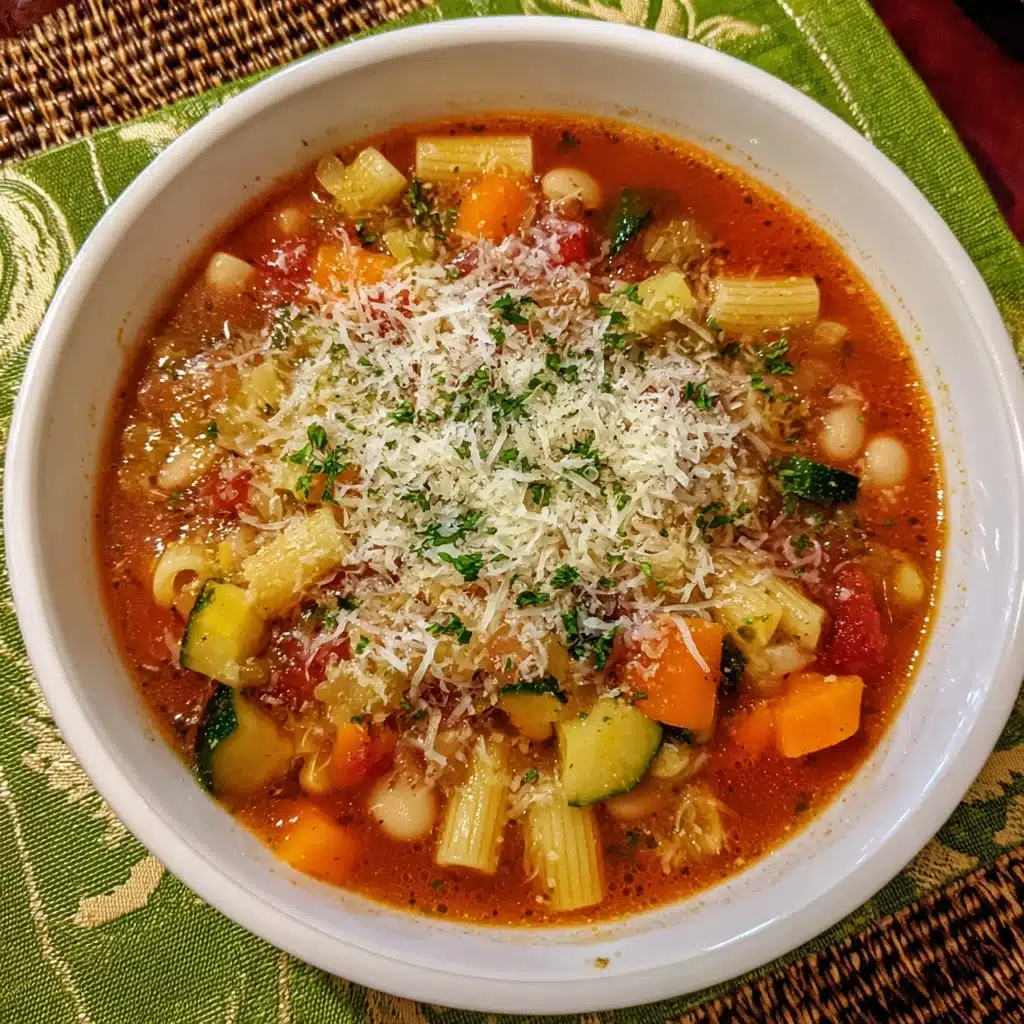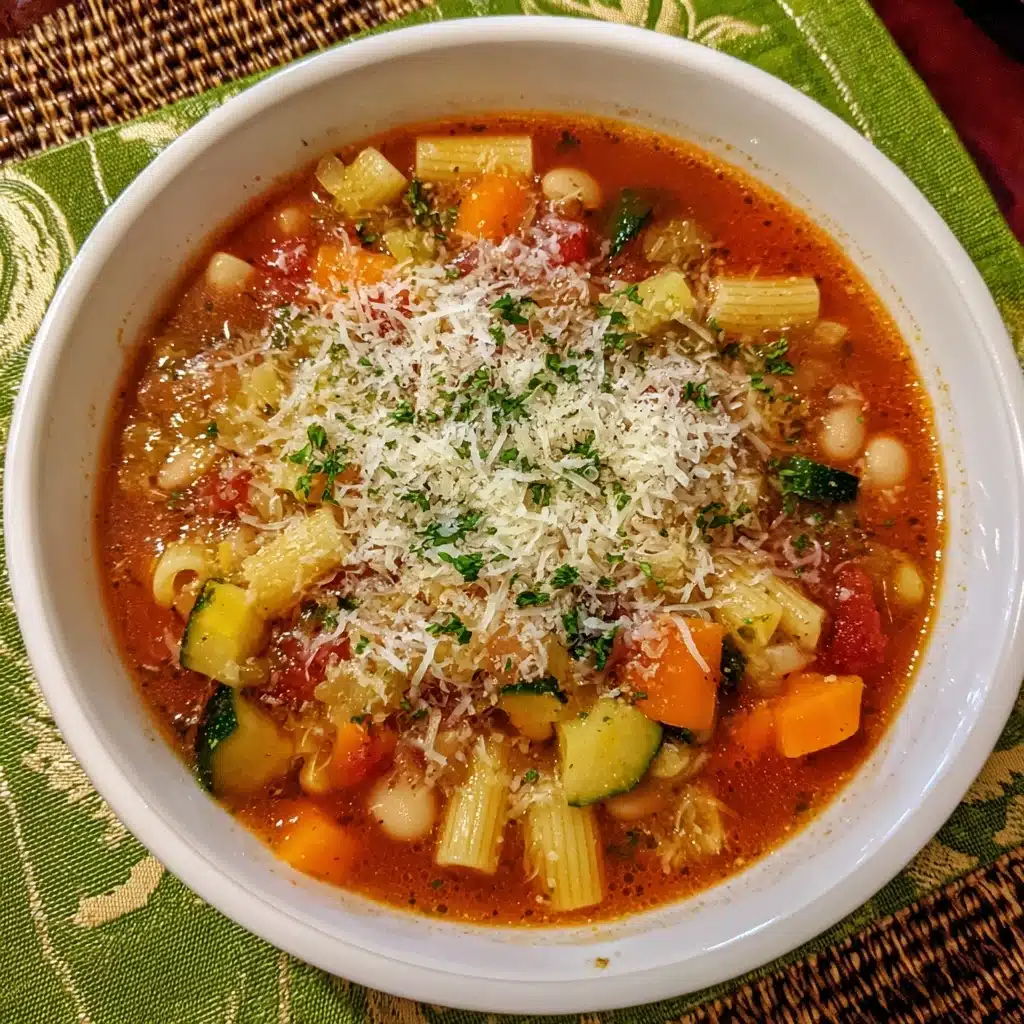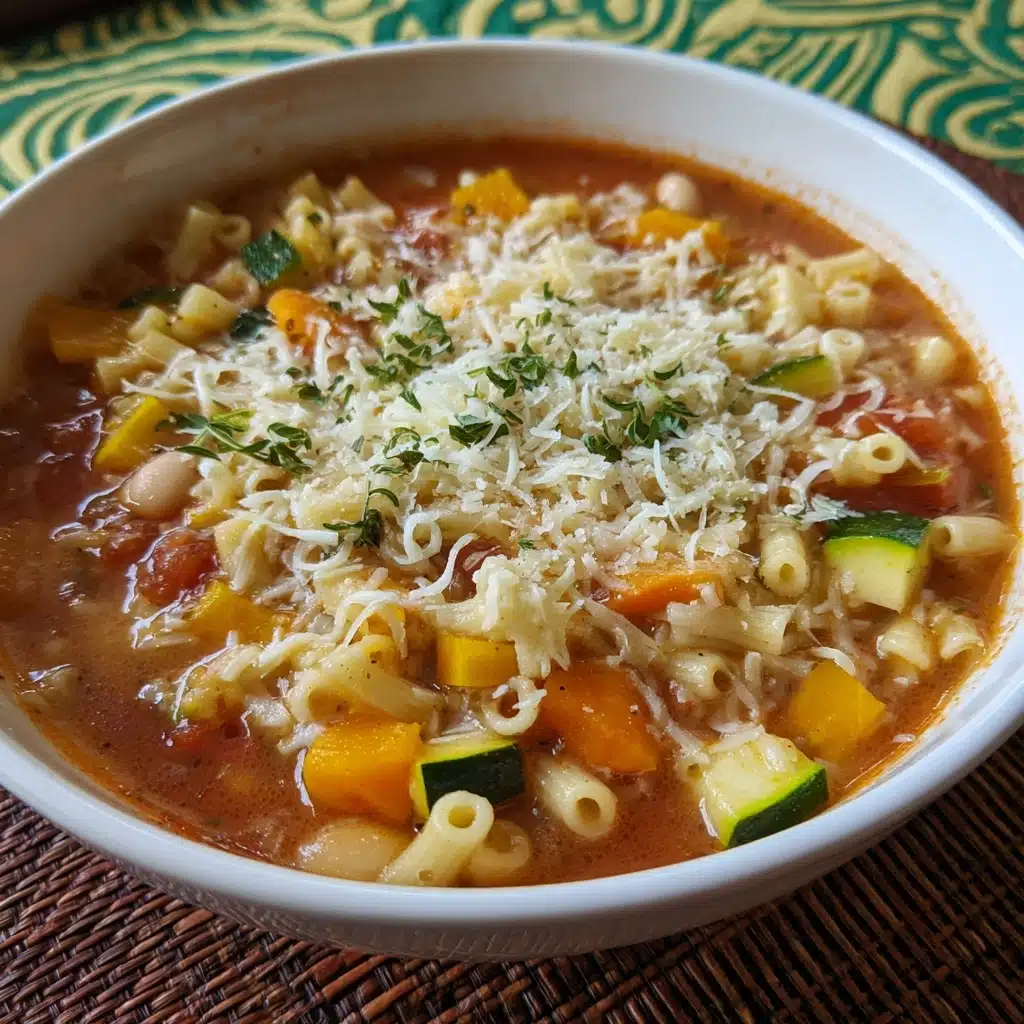Nothing says comfort quite like a steaming bowl of Minestrone Soup. Brimming with colorful vegetables, hearty beans, and a swirl of tiny pasta, this Italian classic is a fantastic way to nourish body and soul on any day of the week. Whether you’re a seasoned home cook or just seeking a straightforward, satisfying meal, this recipe captures all the rustic, wholesome flavors that have made minestrone a beloved kitchen staple for generations. It’s as vibrant on the table as it is in flavor—perfect for sharing with friends, family, or simply treating yourself!
Ingredients You’ll Need
The beauty of homemade Minestrone Soup lies in its simplicity and the magic that happens when each ingredient plays its part. Fresh veggies give color and crunch, beans add satisfying substance, and herbs round the whole thing out with irresistible aromatic depth.
- Olive oil (2 tablespoons): A fruity, silky base for gently softening all those aromatic veggies and lending a touch of richness.
- Yellow onion (1 medium, diced): Forms the flavor bedrock with its natural sweetness that develops as it cooks.
- Garlic (2 cloves, minced): Just a couple of cloves wake up the whole pot with their unmistakable aroma.
- Carrots (2 medium, sliced): Bring a subtle sweetness and a lovely pop of color to every spoonful.
- Celery (2 stalks, sliced): Offers crunch and a gentle, earthy flavor that soaks up the broth beautifully.
- Zucchini (1, diced): Adds tender texture and soaks up the herby, tomato-rich broth.
- Green beans (1 cup, trimmed and cut): Picked for their snap and fresh green flavor that shines after a quick simmer.
- Diced tomatoes (1 can, with juice): Make the broth robust and tangy with every sip.
- Kidney beans (1 can, drained and rinsed): Their earthy bite is a staple in minestrone, adding hearty protein.
- Cannellini beans (1 can, drained and rinsed): Creamy, mild, and incredibly filling—a must for that authentic feel.
- Vegetable broth (6 cups): The backbone of flavor for the soup, bringing it all together (use a good-quality broth for best results).
- Small pasta (1 cup, like ditalini): Tiny shapes give a pleasing chewiness and soak up the flavorful broth without overwhelming the vegetables.
- Dried oregano (1 teaspoon): Lends a signature Italian aroma and a hint of earthy warmth.
- Dried basil (1 teaspoon): Adds a sweet, fragrant lift that makes every bite sing.
- Dried thyme (1/2 teaspoon): Gives the broth a pleasant, woodsy note.
- Bay leaf (1): Subtly infuses the soup with depth while it simmers—don’t forget to fish it out at the end!
- Salt and black pepper (to taste): Essential for balancing all the flavors.
- Fresh spinach (2 cups, chopped): Just before serving, this adds color and freshness in every bowl.
- Grated Parmesan cheese (optional, for serving): A sprinkle on top offers a creamy finish and classic umami kick.
How to Make Minestrone Soup
Step 1: Sauté Aromatics
Start your Minestrone Soup by heating the olive oil in a large, sturdy pot set over medium heat. Once it shimmers, toss in your diced onion. Give it a stir every so often; after about three to four minutes, your kitchen will fill with a heavenly scent and the onions will look glossy and soft—just what you want before adding the next round of aromatics.
Step 2: Add Core Vegetables
Next, toss in the minced garlic, sliced carrots, and celery. Take a moment to stir and let them mingle with the onions, giving everything about five minutes. This helps each veggie release its flavors while the garlic infuses everything with its unmistakable magic. You’ll start to recognize that classic soup base aroma—it’s already irresistible!
Step 3: Layer in More Veggies and Beans
Add the diced zucchini, prepared green beans, canned diced tomatoes (with their juice), kidney beans, and cannellini beans. This is where Minestrone Soup gets its signature bulk and color. Gently mix until everything looks well combined—there’s something incredibly satisfying about watching the pot fill up with so much texture and brightness.
Step 4: Pour in Broth and Seasonings
Pour in the vegetable broth and sprinkle in the dried oregano, dried basil, dried thyme, and drop in the bay leaf. Give everything a gentle stir, then bring the soup to a lively boil. As soon as it starts bubbling, reduce the heat and let it simmer uncovered for about 15 to 20 minutes so the flavors can deepen and mingle.
Step 5: Cook the Pasta
Add your cup of small pasta right into the pot. Keep it simmering for another eight to ten minutes, stirring occasionally so nothing sticks. The pasta should turn tender but still hold its shape nicely—adding those cozy bites that make this soup so satisfying.
Step 6: Finish with Greens and Season
At the end, stir in the chopped spinach. It wilts quickly, just two to three minutes is enough, adding a final touch of freshness. Fish out the bay leaf, and give the soup a taste—now’s the moment to adjust the salt and pepper to suit your preferences. Ladle the hot Minestrone Soup into your favorite bowls and, if desired, finish with a flutter of grated Parmesan cheese.
How to Serve Minestrone Soup

Garnishes
A bowl of Minestrone Soup is wonderful on its own, but the right garnish can truly elevate it. A sprinkle of freshly grated Parmesan cheese adds irresistible creaminess, while a drizzle of extra-virgin olive oil gives a gorgeous sheen and a fruity finish. Fresh herbs like basil or parsley are always a welcome touch for color and aroma. For a burst of bold Italian flavor, a spoonful of pesto on top is pure magic.
Side Dishes
Minestrone Soup pairs beautifully with the simplest of sides. Think rustic Italian bread—something with a good crust, ready to soak up every drop of broth. For a lighter option, a crisp green salad dressed with lemon and olive oil brings freshness to the meal. Cheese toasts, focaccia, or even a bowl of olives can round out the table for a real trattoria experience at home.
Creative Ways to Present
If you’re hosting or just want to make dinner feel extra special, try serving Minestrone Soup in individual crocks or wide mugs for that cozy, bistro feel. You can also set up a “garnish bar” with shredded cheeses, sautéed greens, and croutons so everyone can customize their bowl. For a fun twist, swirl a bit of basil pesto through the soup just before serving—a simple touch that adds color and extra flavor!
Make Ahead and Storage
Storing Leftovers
Minestrone Soup is even better the next day, making it a meal prep hero. Let any leftovers cool completely, then transfer to airtight containers. Stored in the refrigerator, the soup will keep happily for up to four days, ready to heat and enjoy at a moment’s notice.
Freezing
This soup is a dream for the freezer. Portion cooled Minestrone Soup into freezer-safe containers, leaving an inch at the top for expansion. It’ll store well for up to three months. If you’re making it specifically to freeze, consider cooking the pasta separately and adding it after reheating, so it doesn’t get too soft over time.
Reheating
To reheat, simply pour the desired amount into a saucepan and warm gently over medium-low heat until steaming hot. If the soup has thickened from storage or the pasta has absorbed more liquid, just add a splash of water or broth to restore the perfect consistency. Give it a taste and adjust the seasoning—freshly grated cheese or herbs add a lovely finishing touch to revive the flavors.
FAQs
Can I make Minestrone Soup gluten-free?
Absolutely! Simply substitute your favorite gluten-free small pasta, or try using rice or quinoa for a fun twist. The soup is naturally gluten-free aside from the pasta, so this is an easy swap.
What vegetables can I use if I don’t have all the ones listed?
The beauty of Minestrone Soup is in its flexibility. Swap zucchini for yellow squash, use potatoes instead of pasta, or add in seasonal veggies like cabbage or kale. It’s all about making it your own with what’s fresh and on hand.
Can Minestrone Soup be made vegan?
Yes, Minestrone Soup is vegetarian by default, and it’s vegan as long as you skip the Parmesan cheese or use a vegan alternative. The simple combination of beans, pasta, and a rainbow of vegetables is satisfying on its own!
Is it necessary to use both kinds of beans?
While kidney and cannellini beans are traditional for their texture and flavor, you can absolutely substitute with what you like or have in the pantry—chickpeas, black beans, or navy beans all work deliciously.
Can I use fresh herbs instead of dried?
Definitely! Fresh oregano, basil, or thyme can be added toward the end of cooking for a brighter, lighter flavor. Use about three times the amount of fresh herbs compared to dried, and tear or chop them to release their fragrant oils.
Final Thoughts
If you’re searching for a meal that combines comfort, color, and a burst of Italian spirit, Minestrone Soup truly delivers. There’s just something special about dipping your spoon into a bowl of homemade goodness, knowing every ingredient brings a touch of nourishment and joy. I hope you give this recipe a try and make it your own; it’s the kind of soup that invites creativity and brings people together one ladleful at a time!
Print
Minestrone Soup Recipe
- Prep Time: 15 minutes
- Cook Time: 35 minutes
- Total Time: 50 minutes
- Yield: 6 servings
- Category: Main Course
- Method: Stovetop
- Cuisine: Italian
- Diet: Vegetarian
Description
A comforting and hearty Minestrone Soup recipe that is packed with vegetables, beans, pasta, and flavorful herbs. This Italian classic is perfect for a cozy dinner and can be easily customized with your favorite ingredients.
Ingredients
Vegetable Base:
- 2 tablespoons olive oil
- 1 medium yellow onion, diced
- 2 cloves garlic, minced
- 2 medium carrots, sliced
- 2 celery stalks, sliced
- 1 zucchini, diced
- 1 cup green beans, trimmed and cut into 1-inch pieces
Soup Components:
- 1 (15-ounce) can diced tomatoes with juice
- 1 (15-ounce) can kidney beans, drained and rinsed
- 1 (15-ounce) can cannellini beans, drained and rinsed
- 6 cups vegetable broth
- 1 cup small pasta, like ditalini
- 1 teaspoon dried oregano
- 1 teaspoon dried basil
- 1/2 teaspoon dried thyme
- 1 bay leaf
- Salt and black pepper, to taste
- 2 cups chopped fresh spinach
- Grated Parmesan cheese for serving (optional)
Instructions
- Prepare the Base: Heat olive oil in a large pot, sauté onion until softened. Add garlic, carrots, and celery, cook for 5 minutes.
- Cook the Vegetables: Incorporate zucchini, green beans, tomatoes, beans, broth, herbs. Simmer for 15–20 minutes.
- Add Pasta: Introduce pasta, cook for 8–10 minutes until tender.
- Finish the Soup: Stir in spinach, cook until wilted. Season with salt and pepper. Remove bay leaf before serving.
- Serve: Ladle soup into bowls, top with Parmesan if desired.
Notes
- You can substitute kale or Swiss chard for spinach.
- Use gluten-free pasta if needed.
- For extra richness, add a spoonful of pesto when serving.









